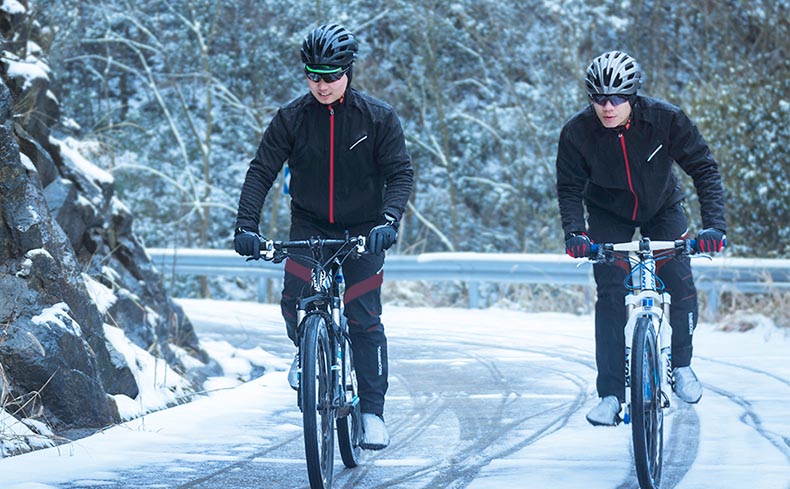Cycling enthusiasts don’t let cold weather hinder their passion for riding. Winter cycling can be challenging, but with the right gear, you can stay warm, comfortable, and safe on the roads. In this blog post, we will share some essential tips for selecting and using winter cycling gear.
Before discussing how to ride safely in winter, let’s first understand the benefits of winter cycling.If you’re an environmentalist, winter cycling is undoubtedly low-carbon and environmentally friendly.On the other hand, it also keeps you active during the cold winter months, ensuring you are healthy and ready to return to cycling in the spring.From a commuting standpoint, cycling is a hassle free ride, even in winter.
Before embarking on a cold-weather ride, prepare your best “teammate”-an electric bike that can withstand the cold and adapt to all kinds of terrain.It is recommended to choose an electric bicycle that is economical, has wide tires and can withstand cold.

Aluminum alloy wheel–aluminum alloy cold, not easy to deform.HOTEBIKE electric bicycles all use 6061 aluminum alloy frame, waterproof, cold, durable.
Flat pedaling-When cycling in winter, you need to be able to land quickly on both feet, and locking the pedal is definitely not a good option.
Fender–essential!The weather is fickle, so unless you want to ride in the winter with wet, cold hips, get a fender.
Lower the seat-it’s the same principle as using flat pedals. You don’t want to fall out, do you?In unpredictable situations, it’s crucial to land your feet quickly.Lowering the seat height stabilizes the center of gravity and ensures that your feet are firmly grounded in an instant

Preparation is key
1. Layer Up:
Layering is crucial for winter cycling as it helps maintain your body temperature and allows you to adjust accordingly. Start with a moisture-wicking base layer to keep sweat away from your skin and prevent chill. Add an insulating mid-layer, such as a thermal cycling jersey or a fleece jacket, for extra warmth. Finally, wear a windproof and waterproof outer shell to shield yourself from the elements.
2. Insulated Cycling Jacket:
Investing in a good-quality insulated cycling jacket is essential. Look for one that offers insulation while also allowing breathability. A jacket with adjustable cuffs and a high collar will help to lock in heat and keep the cold air out.
3. Cycling Tights or Pants:
To protect your legs from the cold, wear cycling tights or pants made from thermal materials. Look for options with water and wind-resistant properties. Consider tights with reflective details, which enhance your visibility during darker winter riding conditions.
4. Gloves and Hand Warmers:
Cold hands can be uncomfortable and affect your grip on the handlebars. Invest in a pair of well-insulated, wind-resistant gloves specifically designed for cycling. Look for gloves that offer good dexterity, allowing you to easily operate the brakes and shift gears. Additionally, hand warmers can provide extra warmth during exceptionally cold rides.
5. Headwear and Neck Gaiters:
Keep your head and neck warm by wearing a thermal cycling cap or a beanie. Look for options that cover your ears for added warmth. A neck gaiter or a balaclava can provide extra insulation for your neck and can be pulled up to cover your face in extreme cold or wind.
6. Cycling Shoes and Toe Covers:
Cold feet can make your ride uncomfortable and even pose a safety risk. Consider investing in winter cycling shoes that are designed to provide insulation and protection from moisture. Alternatively, you can use toe covers or shoe covers to keep the wind and cold air out.
7. Lights and Reflective Gear:
During the winter months, daylight hours are often limited. Enhance your visibility on the road by attaching lights to your bike and wearing reflective gear. Front and rear lights, along with reflective vests or jackets, make you more visible to motorists, especially in low-light or snowy conditions.
Winter tires
If you are riding in ice and snow, it is also important to prepare a good set of winter or snow tires. Changing to dedicated winter fat or tubeless tires that run at lower pressures will provide more grip during the winter and the chance of a puncture will be slightly reduced. (Recommended reading: The best tires for winter riding)
Finally, your bike needs to be serviced in winter to maintain its best performance.It’s okay to leave your bike outdoors all winter, and some people even think it’s better: it keeps the bike safe and avoids salt buildup caused by the alternating cycle of ice, snow and heat.
However, whether you leave your car outdoors or indoors, be sure to shake off excess snow when you get home and check the brakes before you go out (if you leave it outdoors, the brakes may freeze).It should also be noted that the chain should be cleaned/lubricated from time to time to avoid rust.These measures can basically keep the bicycle healthy and make it smooth transition into spring.
Snow Ebike
If you also need a suitable electric snow bike, HOTEBIKE A7AT26 will be a good choice.Equipped with a 1000 watt cold-resistant brushless wheel motor and 20*4 inch wide tires, it can easily cope with all kinds of terrain, providing excellent stability and grip.Full suspension makes every ride easy.
Winter cycling can be an enjoyable and invigorating experience with the right gear. By layering up, investing in insulated jackets, tights, gloves, headwear, and appropriate footwear, you can stay warm and comfortable during cold weather rides. Don’t forget to enhance your visibility with lights and reflective gear for added safety. So gear up, embrace the winter, and pedal on!
 hotebike
hotebike